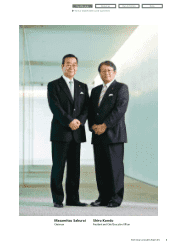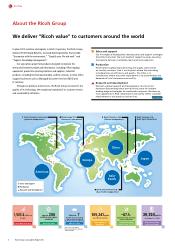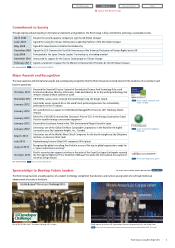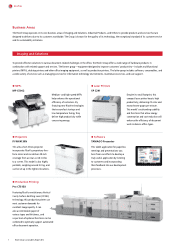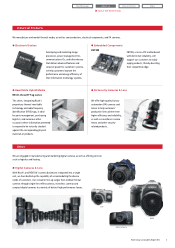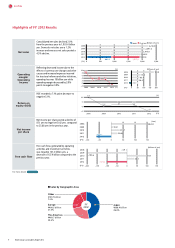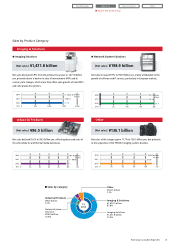Ricoh 2012 Annual Report Download - page 14
Download and view the complete annual report
Please find page 14 of the 2012 Ricoh annual report below. You can navigate through the pages in the report by either clicking on the pages listed below, or by using the keyword search tool below to find specific information within the annual report.
Ricoh Group Sustainability Report 201213
Top Interview
Simultaneously achieving “business creation and integration”
and “restructuring”
Mid-term business challenges and measures
As society and the economy experience a greater number of significant
changes such as advances in Information and Communication Technology
(ICT), manifestation of resource and energy issues and development of
globalization, the Ricoh Group is facing a turning point in its business
strategies. Specifically in one of our core business areas, Imaging and
Solutions, we have recognized trends in customer demand, which include:
1) Improvement of workflow and reduction of total cost of ownership
(TCO)
2) Shift from “owning equipment” to “using services”
3) Higher awareness of environmental conservation in order to realize
low-carbon offices
To meet these new demands, it has become more important for us to
combine multiple products and services to be offered as a set solution for
the specific problems of individual customers.
The work styles of our customers are also changing. As greater
amounts of information are being digitized, use of cloud computing,
smartphones and tablet PCs has been rapidly spreading. As a result,
communication media are diversified and the costs for information
sharing have been drastically dropped. Diverse ways to generate, store,
search and use information have allowed significant advancement. Now,
demands are being shifted to new products and services that can supply
a good work environment wherever and whenever they are required.
Presently, society demands that global companies play a role not only
as entities that generate economic value but also as organizations that
make contributions toward solving issues facing the Earth and its people,
as well as in creating a sustainable society. At the same time, elements
influencing corporate activities are experiencing increased diversification
and expansion in their range of effects. Now, not only companies
themselves, but also their business partners are being affected.
In order to correctly respond to these changes in the demands
of customers and society, the Ricoh Group plans and implements
management strategies that are based on three key elements: “economy,”
“society” and the “environment.” We work to both further the growth of
the Group and to create a sustainable society.
The 17th MTP
Our goals for the 17th MTP (implemented from fiscal 2012 to 2014) are
to “strive for a global brand, create a future with new innovation and
achieve ‘growth’ and ‘restructuring’ simultaneously.” Under these goals,
we work on two basic strategies: “business creation and integration” and
“establishment of highly effective management.”
● Business creation and integration
Imaging and Solutions, the core business of the Ricoh Group, has now
faced a turning point in terms of reviewing its business structure. We will
make this area a stronger base for our business operations by improving
the performance of our MFPs and other printers. For example, we will
improve their compatibility with other network equipment and reduce
their environmental impact. We are also working on our solution services
in various areas such as document management. Our customers are now
placing more value on “intangible assets (use of services)” in addition to
“tangible goods (ownership of products).” To respond to this change, we
will seize upon every growth opportunity that is related to conventional
businesses for offices. In particular, we will place more emphasis on new
businesses, including managed document services, IT services, projection
systems and video conference systems. By combining existing products
and services with those that are new, we are able to place higher value
on the products and/or services we offer to our customers. To accomplish
this, we fully employ our advantage—the strong relationship we have
built with our customers.
In the expanding markets of emerging countries, we see expectations
for product functions and services that are different from those we see in
developed markets. For these markets, we first identify the local functions
and prices that are expected and reflect these into our products, starting
at the design stage. We also prepare locally workable sales systems to
expand our business.
■ Workplaces and communication in the future
Working on an anywhere, anytime basis
Diversified data output
Physical office Virtual office
Cloud/
networking
Home office
In transit
MFPMFP
Paper
Printer
Tablets
Projector
Satellite officeCustomer site
Something
new
Images,
documents,
data, etc.
See page 15
Major initiatives for business
creation and integration
1. Acquire and maintain top market share in the core business
4. Accelerate business growth in emerging markets
2. Enhance customer value by creating synergies among new
businesses and the core business
5. Realize profit contributions from the Production Printing
business
3. Accelerate business structure transformation to service
businesses in the markets of developed countries



